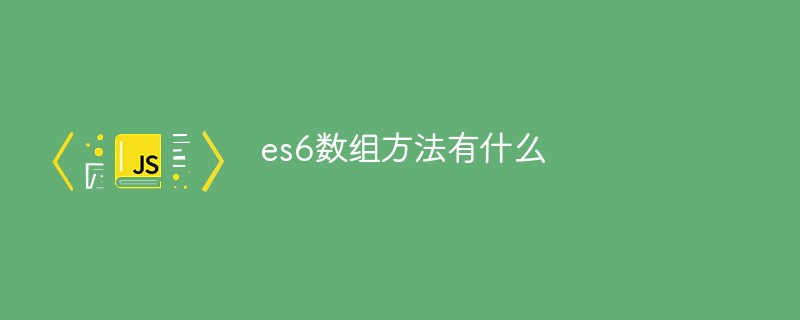es6数组方法有什么
- 青灯夜游原创
- 2021-09-10 14:31:067718浏览
es6数组方法有:“from()”、“of()”、“copyWithin()”、“fill()”、“find()”、“findIndex()”、“includes()”、“entries()”、“keys()”、“values()”等。

本教程操作环境:windows7系统、ECMAScript 6版、Dell G3电脑。
传统Array 对象方法
- toSource() 返回该对象的源代码。
- toString() 把数组转换为字符串,并返回结果。
- toLocaleString() 把数组转换为本地数组,并返回结果。
- valueOf() 返回数组对象的原始值
| 修改原数组 | 不修改原数组 |
|---|---|
| push, pop | concat |
| unshift,shift | join |
| sort | slice |
| reverse | indexOf(),lastIndexOf() |
| splice | forEach |
| copyWithin | map |
| fill | filter |
| some | |
| every | |
| reduce,reduceRight | |
| includes | |
| finde,findIndex | |
| entries(),keys(),values() |
修改原数组
- push() 向数组的末尾添加一个或更多元素,并返回新的长度。
- unshift() 向数组的开头添加一个或更多元素,并返回新的长度。
- pop() 删除并返回数组的最后一个元素
- shift() 删除并返回数组的第一个元素
- sort() 对数组的元素进行排序
- reverse() 颠倒数组中元素的顺序。
- splice() 删除元素,并向数组添加新元素。
splice
语法
arrayObject.splice(index,howmany,item1,.....,itemX)
var arr = new Array(); arr[0] = "George"; arr[1] = "John"; arr[2] = "Thomas"; arr.splice(2,1); //"George", "John" arr.splice(1,0,"William"); //"George", "William", "John" arr.splice(2,1,"haha"); //"George", "William", "haha"
不修改原数组
- concat() 连接两个或更多的数组,并返回结果。
- join() 把数组的所有元素放入一个字符串。元素通过指定的分隔符进行分隔。
- slice() 从某个已有的数组返回选定的元素
slice
语法
arrayObject.slice(start,end);
- start 必需。规定从何处开始选取。可为负,从数组尾部开始算起。
- end 可选。规定从何处结束选取。如果没有指定,那么切分的数组包含从 start 到数组结束的所有元素。可为负,从数组尾部开始算起。
var arr = new Array(); arr[0] = "George"; arr[1] = "John"; arr[2] = "Thomas"; arr.slice(2,1); //[] arr.slice(1,2); //"William" arr.slice(-2,-1); //"William"
将类似数组的对象(比如arguments)转换为真实的数组
Array.prototype.slice.call(arguments);
ES5新增数组
- 索引方法:indexOf(),lastIndexOf()
- 迭代方法:forEach()、map()、filter()、some()、every()
- 归并方法:reduce()、reduceRight()
方法并不会修改原数组
索引方法
indexOf
array.indexOf(searchElement[, fromIndex])
- 返回整数索引值,如果没有匹配(严格匹配),返回-1。
- fromIndex可选,表示从这个位置开始搜索,若缺省或格式不合要求,使用默认值0。
var data = [2, 5, 7, 3, 5];
console.log(data.indexOf(5, "x")); // 1 ("x"被忽略)
console.log(data.indexOf(5, "3")); // 4 (从3号位开始搜索)lastIndexOf
array.lastIndexOf(searchElement[, fromIndex])
- 从字符串的末尾开始查找,而不是从开头。
- fromIndex的默认值是array.length - 1。
var data = [2, 5, 7, 3, 5]; console.log(data.lastIndexOf(5)); // 4 console.log(data.lastIndexOf(5, 3)); // 1 (从后往前,索引值小于3的开始搜索) console.log(data.lastIndexOf(4)); // -1 (未找到)
两个方法在比较第一个参数与数组中的每一项时,会使用全等操作符, 要求必须完全相等,否则返回-1。
迭代方法
每个方法都接受两个参数,第一个参数callback(回调函数,必选),第二个参数是一个可选的上下文参数。
- 其中第一个参数callback接受三个参数, 当前项的值、当前项在数组中的索引、数组对象本身。即 function(value,index,arr) {};需要注意的是与我们常用的jQuery中封装的方法区别在第一个参数和第二个参数,即index和value的顺序是相反的。
- 第二个参数是一个可选的上下文参数,是执行第一个函数参数的作用域对象,也就是上面说的callback中this所指向的值。 如果这第2个可选参数不指定,则使用全局对象代替(在浏览器是为window),严格模式下甚至是undefined。
需要注意的是除了forEach()方法,其余的迭代方法中callback需要有return值否则会返回undefined。
forEach
forEach()对数组进行遍历循环,对数组中的每一项运行给定的函数,这个方法没有返回值。
[].forEach(function(value, index, array) {
// ...
}, [ thisObject]);- forEach除了接受一个必须的回调函数参数,还可以接受一个可选的上下文参数(改变回调函数里面的this指向)(第2个参数)。
- 如果这第2个可选参数不指定,则使用全局对象代替(在浏览器是为window),严格模式下甚至是undefined.
[1, 2, 3, 4].forEach(function (item, index, array) {
console.log(array[index] == item); // true
sum += item;
});
alert(sum); // 10
var database = {
users: ["张含韵", "江一燕", "李小璐"],
sendEmail: function (user) {
if (this.isValidUser(user)) {
console.log("你好," + user);
} else {
console.log("抱歉,"+ user +",你不是本家人");
}
},
isValidUser: function (user) {
return /^张/.test(user);
}
};
// 给每个人法邮件
database.users.forEach( // database.users中人遍历
database.sendEmail, // 发送邮件
database // 使用database代替上面标红的this
);
// 结果:
// 你好,张含韵
// 抱歉,江一燕,你不是本家人
// 抱歉,李小璐,你不是本家map
map()指“映射”,对数组中的每一项运行给定的函数,返回每次函数调用的结果组成的数组。
[].map(function(value, index, array) {
// ...
}, [ thisObject]);var data = [1, 2, 3, 4];
var arrayOfSquares = data.map(function (item) {
return item * item;
});
alert(arrayOfSquares); // 1, 4, 9, 16filter
filter(),“过滤”,对数组中的每一项运行给定函数,返回满足过滤条件组成的数组。
array.filter(callback,[ thisObject]);
- filter的callback函数需要返回布尔值true或false。
- 返回值只要是弱等于== true/false就可以了,而非非得返回 === true/false。
var arr3 = [1, 2, 3, 4, 5, 6, 7, 8, 9, 10];
var flag = arr3.filter(function(value, index) {
return value % 3 === 0;
});
console.log(flag); // [3, 6, 9]every
every(),判断数组中每一项都是否满足所给条件,当所有项都满足条件,才会返回true。
注意: 空数组,则返回true
array.every(callback,[ thisObject]);
var arr4 = [1, 2, 3, 4, 5];
var flag = arr4.every(function(value, index) {
return value % 2 === 0;
});
console.log(flag); // falsesome
some(),判断数组中是否存在满足条件的项,只要有一项满足条件,就会返回true。
注意: 空数组,则返回false
array.some(callback,[ thisObject]);
var arr5 = [1, 2, 3, 4, 5];
var flag = arr5.some(function(value, index) {
return value % 2 === 0;
});
console.log(flag); // true归并方法
这两个方法相比前面可能稍微复杂一些,它们都会迭代数组中的所有项,然后生成一个最终返回值。这两个方法接收两个参数。
- 第一个参数callback,函数接受4个参数分别是(初始值total必选,当前值currentValue必选,索引值currentIndex可选,当前数组arr可选),函数需要返回一个值,这个值会在下一次迭代中作为初始值。
- 第二个参数是迭代初始值(initialValue),参数可选,如果缺省,初始值为数组第一项,从数组第一个项开始叠加,缺省参数要比正常传值少一次运算。
reduce
reduce() 方法接收一个函数作为累加器,数组中的每个值(从左到右)开始缩减,最终计算为一个值。 reduce() 对于空数组是不会执行回调函数的。
array. reduce(function(total, currentValue, currentIndex, array) {<br> // ...<br>});
var arr9 = [1, 2, 3, 4];
var sum9 =arr9.reduce(function (total, curr, index, array) {
return total * curr;
});
console.log(sum9); // 24
var sum9_1 =arr9.reduce(function (total, curr, index, array) {
return total * curr;
}, 10);
console.log(sum9_1); // 240reduceRight
reduceRight()和reduce()相比,用法类似,差异在于reduceRight是从数组的末尾开始实现的。
array.reduceRight(callback,[ thisObject]);
var arr9 = [2, 45, 30, 80];
var flag = arr9.reduceRight(function (total, curr, index) {
return total - curr;
});
var flag_1 = arr9.reduceRight(function (total, curr, index) {
return total - curr;
},200);
console.log(flag); // 3
console.log(flag_1); // 43Array方法
isArray
判断参数是否是”Array”返回true或false。
var a = [1,2,3]; Array.isArray(a); //true
ES6数组方法
Array方法
Array.from()
用于将两类对象转为真正的数组:类似数组的对象(array-like object)和可遍历(iterable)的对象(包括 ES6 新增的数据结构 Set 和 Map)。
let arrayLike = {
'0': 'a',
'1': 'b',
'2': 'c',
length: 3
};
let arr2 = Array.from(arrayLike); // ['a', 'b', 'c']Array.from还可以接受第二个参数,作用类似于数组的map方法,用来对每个元素进行处理,将处理后的值放入返回的数组。
Array.from(arrayLike, x => x * x); // 等同于 Array.from(arrayLike).map(x => x * x); Array.from([1, 2, 3], (x) => x * x) // [1, 4, 9]
Array.of()
用于将一组值,转换为数组。
Array.of(3, 11, 8) // [3,11,8] Array.of(3) // [3]
实例方法
会改变原数组
copyWithin()
在当前数组内部,将指定位置的成员复制到其他位置(会覆盖原有成员),然后返回当前数组。
array. copyWithin(target, start = 0, end = this.length);
- target(必需):从该位置开始替换数据。如果为负值,表示倒数。
- start(可选):从该位置开始读取数据,默认为 0。如果为负值,表示倒数。
- end(可选):到该位置前停止读取数据,默认等于数组长度。如果为负值,表示倒数。
// 将3号位复制到0号位 [1, 2, 3, 4, 5].copyWithin(0, 3, 4) // [4, 2, 3, 4, 5] // -2相当于3号位,-1相当于4号位 [1, 2, 3, 4, 5].copyWithin(0, -2, -1) // [4, 2, 3, 4, 5]
fill()
使用给定值,填充一个数组。
['a', 'b', 'c'].fill(7); // [7, 7, 7] let arr = new Array(3).fill([]); arr[0].push(5); // [[5], [5], [5]]
不会改变原数组
find()
用于找出第一个符合条件的数组成员。它的参数是一个回调函数,所有数组成员依次执行该回调函数,直到找出第一个返回值为true的成员,然后返回该成员。如果没有符合条件的成员,则返回undefined。
find方法的回调函数可以接受三个参数,依次为当前的值、当前的位置和原数组。
[1, 4, -5, 10].find((n) => n < 0)
// -5
[1, 5, 10, 15].find(function(value, index, arr) {
return value > 9;
}) // 10findIndex()
findIndex方法的用法与find方法非常类似,返回第一个符合条件的数组成员的位置,如果所有成员都不符合条件,则返回-1。
[1, 5, 10, 15].findIndex(function(value, index, arr) {
return value > 9;
}) // 2includes()
返回一个布尔值,表示某个数组是否包含给定的值。
[1, 2, 3].includes(2) // true
entries(),keys() 和 values()
ES6提供了三个新方法:entries()、keys()和values(),用来遍历数组。它们都返回一个遍历器对象,可以用for...of循环进行遍历,唯一的区别是keys()是对数组的键名的遍历、values()是对数组键值的遍历,entries()方法是对数值的键值对的遍历。
for (let index of ['a', 'b'].keys()) {
console.log(index);
}
// 0
// 1
for (let elem of ['a', 'b'].values()) {
console.log(elem);
}
// 'a'
// 'b'
for (let [index, elem] of ['a', 'b'].entries()) {
console.log(index, elem);
}
// 0 "a"
// 1 "b"如果不使用for...of循环,可以手动调用遍历器对象的next方法,进行遍历。
let letter = ['a', 'b', 'c']; let entries = letter.entries(); console.log(entries.next().value); // [0, 'a'] console.log(entries.next().value); // [1, 'b'] console.log(entries.next().value); // [2, 'c']
【推荐学习:javascript高级教程】
以上是es6数组方法有什么的详细内容。更多信息请关注PHP中文网其他相关文章!

